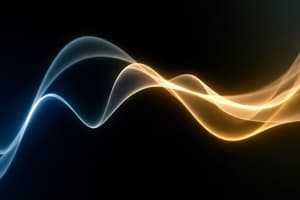Podcast
Questions and Answers
What is the speed of light in a vacuum?
What is the speed of light in a vacuum?
- 450,000 kilometers per second
- 299,792 kilometers per second (correct)
- 300,000 kilometers per second
- 150,000 kilometers per second (correct)
Which phenomenon describes the bending of light as it passes from one medium to another?
Which phenomenon describes the bending of light as it passes from one medium to another?
- Refraction (correct)
- Reflection
- Diffraction
- Interference
What type of color mixing involves combining different colors of light?
What type of color mixing involves combining different colors of light?
- Additive Color Mixing (correct)
- Dye Blending
- Subtractive Color Mixing
- Pigment Mixing
What type of sources includes the Sun and stars?
What type of sources includes the Sun and stars?
How are wavelength and frequency related?
How are wavelength and frequency related?
Which type of light wave interaction creates patterns of constructive and destructive interference?
Which type of light wave interaction creates patterns of constructive and destructive interference?
What are the primary colors used in subtractive color mixing?
What are the primary colors used in subtractive color mixing?
What type of light interaction occurs when light bounces off a surface?
What type of light interaction occurs when light bounces off a surface?
Flashcards are hidden until you start studying
Study Notes
Properties of Light
- Nature: Light is an electromagnetic wave that exhibits both wave-like and particle-like properties (wave-particle duality).
- Speed: Travels at approximately 299,792 kilometers per second (in a vacuum).
- Wavelength: The distance between successive peaks of a wave; determines color in visible light.
- Frequency: The number of waves that pass a point per second; inversely proportional to wavelength.
Electromagnetic Spectrum
- Visible Light: The portion of the spectrum that is visible to the human eye (approximately 400-700 nm).
- Other Types: Includes radio waves, microwaves, infrared, ultraviolet, X-rays, and gamma rays, which differ in wavelength and frequency.
Behavior of Light
- Reflection: Bouncing of light off surfaces; follows the law of reflection (angle of incidence = angle of reflection).
- Refraction: Bending of light as it passes from one medium to another; depends on the refractive indices of the materials.
- Diffraction: The spreading of light waves when they encounter an obstacle or slit.
- Interference: The phenomenon where two light waves superpose to form a resultant wave, resulting in patterns of constructive and destructive interference.
Light Sources
- Natural Sources: The Sun, stars, and bioluminescent organisms.
- Artificial Sources: Incandescent bulbs, fluorescent lights, LEDs, lasers.
Color and Light
- Additive Color Mixing: Combining different colors of light to create new colors; primary colors are red, green, and blue (RGB).
- Subtractive Color Mixing: Mixing pigments or dyes; primary colors are cyan, magenta, and yellow (CMY).
Human Vision
- Photoreceptors: Rods (sensitive to low light, no color) and cones (sensitive to color).
- Color Perception: The brain interprets signals from cones to perceive color; influenced by lighting conditions.
Applications of Light
- Optics: Study of light behavior; includes lenses, mirrors, and optical instruments.
- Photography: Capturing images through the interaction of light with photosensitive materials.
- Communication: Fiber optics use light to transmit data over long distances efficiently.
Important Concepts
- Intensity: Brightness of light, related to the amount of energy per unit area.
- Polarization: Orientation of light waves; can be natural or induced.
- Luminosity: Measure of the total amount of light emitted by a source.
Properties of Light
- Light exhibits wave-particle duality, manifesting as both an electromagnetic wave and particle.
- Travels at a speed of approximately 299,792 kilometers per second in a vacuum.
- Wavelength determines color in visible light, measured as the distance between successive wave peaks.
- Frequency indicates how many waves pass a point per second and is inversely related to wavelength.
Electromagnetic Spectrum
- Visible light ranges from approximately 400 to 700 nanometers and is the part of the spectrum seen by the human eye.
- The spectrum includes various types: radio waves, microwaves, infrared, ultraviolet, X-rays, and gamma rays, differing in wavelength and frequency.
Behavior of Light
- Reflection occurs when light bounces off surfaces, adhering to the law of reflection (angle of incidence equals angle of reflection).
- Refraction is the bending of light when passing from one medium to another, influenced by the materials' refractive indices.
- Diffraction is the spreading of light waves upon encountering an obstacle or slit.
- Interference results from superposition of two light waves, creating patterns of constructive and destructive interference.
Light Sources
- Natural light sources include the Sun, stars, and bioluminescent organisms producing light through biological processes.
- Artificial light sources encompass incandescent bulbs, fluorescent lights, LEDs, and lasers developed for various applications.
Color and Light
- Additive color mixing involves combining light colors (red, green, blue) to produce new colors.
- Subtractive color mixing relates to pigments or dyes, using primary colors cyan, magenta, and yellow.
Human Vision
- Rods are photoreceptors sensitive to low light levels without color detection, while cones are responsible for color sensitivity.
- Color perception is a result of brain interpretation of signals from cones, influenced by environmental lighting conditions.
Applications of Light
- Optics studies the behavior of light through lenses, mirrors, and optical instruments, facilitating various technological uses.
- Photography captures images through the interaction of light with photosensitive materials.
- Communication systems utilize fiber optics to transmit data over long distances effectively using light.
Important Concepts
- Intensity refers to the brightness of light, correlating with the energy amount per unit area.
- Polarization describes the orientation of light waves, which can occur naturally or be induced.
- Luminosity assesses the total output of light emitted by a source, important in evaluating brightness levels.
Studying That Suits You
Use AI to generate personalized quizzes and flashcards to suit your learning preferences.




